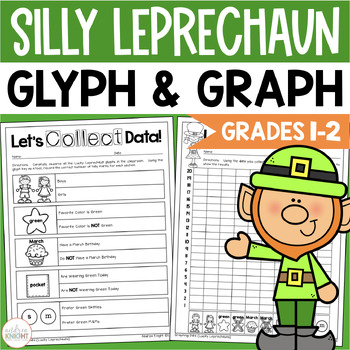St. Patrick's Day Math Activity with a Glyph and Data Graph Lesson - Grades 1-2
- PDF
Also included in
- This BUNDLE includes the the eight (8) HOLIDAY GLYPH & GRAPH MATH SETS from my store, including: Freaky FrankiesQuirky TurkeysRascally ReindeerSnazzy SnowmenLove BugsLucky LeprechaunsFunny BunniesSummer Fun (Sailboats and Ice Cream) TEACHERS LIKE YOU SAID:⭐️⭐️⭐️⭐️⭐️ “This resource helps build listePrice $18.00Original Price $25.00Save $7.00
Description
ST. PATRICK'S DAY ART AND MATH ACTIVITY - LUCKY LEPRECHAUNS
This holiday-themed math activity actually begins with a simple directed drawing of a leprechaun.
DIRECTED DRAWING lessons strengthen many skills including:
- listening and following directions
- understanding logical sequence
- improving hand-eye coordination with fine motor development
- developing spatial awareness
The MATH portion of this lesson provides children with an opportunity to:
- read and understand a 5-point glyph key
- collect data using tally marks
- represent data using a bar graph template
- analyze data
The download includes:
- Teacher Directions
- Two Options for the Glyph Key
- Student Worksheets
- Photos of Student Samples
Click on the PREVIEW above to see samples.
TEACHERS LIKE YOU SAID:
⭐️⭐️⭐️⭐️⭐️ “My students and I absolutely LOVED doing this activity today. Super fun and engaging. The graphing and questions were spot on for my second graders. I would highly recommend this product to anyone looking for a good educational activity for the holiday." (Cassandra S.)
⭐️⭐️⭐️⭐️⭐️ “Thank you for the clear instructions and engaging activity!" (Jen H.)
⭐️⭐️⭐️⭐️⭐️ “So much fun! Kiddos were focused on their work and happy to draw and color for the duration of the activity. Ended the school day with some happy little artists!" (Lori L.)
RELATED BLOG POST:
YOU MAY ALSO LIKE:
Thank you for your interest in this item.
Happy teaching!
❤️ After purchasing, REMEMBER TO LEAVE FEEDBACK.
Each review leads to TPT CREDIT you can use for future purchases!
Let's stay connected!
BLOG: Andrea Knight - Teacher Author
PINTEREST: Andrea Knight on Pinterest
FACEBOOK: Andrea Knight - Teacher Author on Facebook
INSTAGRAM: Andrea Knight - Teacher Author on Instagram
Also, be sure to FOLLOW ME ON TPT. This is the best way to stay in the loop when new resources are launched. New listings are always discounted by 50% for the first 24 hours. By following, you'll never miss out on the savings!
Copyright © Andrea Knight
All rights reserved by the author.
Permission to copy for single classroom use only.






